A week spent in the most fuel efficient hybrid in America
Pros:
Fuel economy
Interior room
Interior and exterior fit and finish
Cons:
Average handling and limited steering feedback
Limited side and rear visibility
[caption id="" align="aligncenter" width="410"] 2000 Toyota Prius[/caption]
2000 Toyota Prius[/caption]
The Prius
Although Toyota’s Prius has been around since 2000 here in the U.S., sales of what is now the best-selling hybrid in both the American and world markets didn’t really catch fire until the second-generation model was introduced as a 2004 model towards the end of 2003.
The rest, as they say, is history. The Prius is the first hybrid vehicle to hit both the one million (in May of 2008) and two million (in September of 2010) marks in worldwide sales.
And even though deliveries are certain to be down this year because the spring earthquake and tsunami in Japan caused a serious disruption in production, according to July sales figures from HybridCars.com and Baum & Associates, year to date U.S. Prius sales in 2011 still account for nearly fifty percent of the entire hybrid market. Furthermore, year to date sales also show that it is outselling its nearest competitor, the Hyundai Sonata hybrid, by nearly a ten-to-one margin.
And that, as the saying goes, ain’t hay.
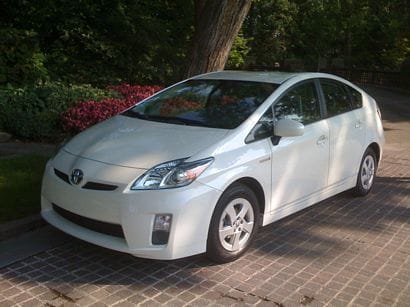
Exterior
It’s hard to be objective when viewing the exterior of the third generation Toyota Prius. You can say what you will, but in the short span of seven years its design has become every bit as iconic as the Chevrolet Corvette, Ford Mustang, Mazda Miata, Mini, Porsche 911 and Volkswagen Beetle. All vehicles, by the way, that are either sporty or have been around in one form or another for fifty years – heady company, indeed.
Better, then, to compare the current model over 50 mpg car to the second-generation version.
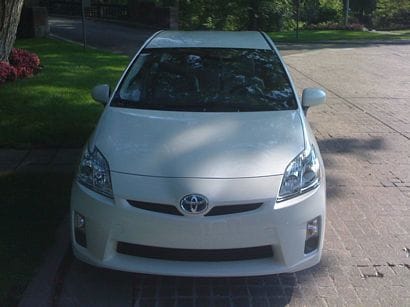
Although they look very similar, comparing them side-by side reveals that not a single body panel was carried over. Beginning in front, the somewhat awkward-looking vertically-stacked trapezoidal headlights of the second gen model have been replaced by a pair of stylized horizontal enclosures comprised of a conventional bright unit and either a pair of LED’s, or a single halogen, projector beam setup.
The lower air intake is marginally taller and narrower while the parking lights have been moved from its outboard edges to a pair of rectangular openings that flank it.
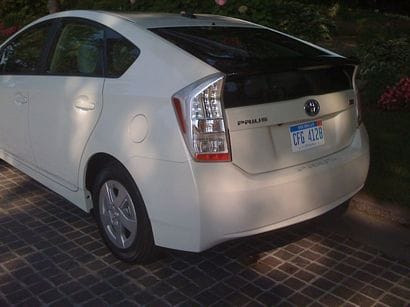
Although the roofline looks similar, its high point has been moved rearward, allowing for more headroom for rear seat passengers. The addition of a body crease that begins at a mid-point along the headlight enclosure and follows the beltline to the taillamp has also toned down the slab-sided look of the older model.
Finally, although the taillights of the two models also appear similar, those of the third generation rake rearward towards the top to meet the trailing edge of an even larger rear spoiler.
All told, the exterior of the newest Prius looks both tighter and sharper in comparison.
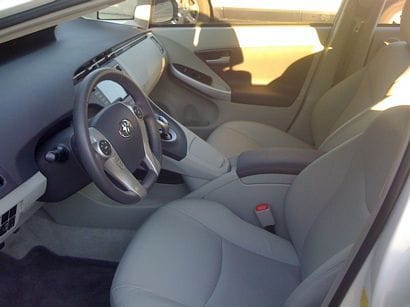
Interior
Even though the flying buttress-like center console takes up more space, the cabin feels both open and airy as this newest Prius interior presents near-Lexus luxury and attention to detail.
Overall, interior fit and finish is outstanding. The front seats are both comfortable and supportive. There is also ample head, shoulder and legroom for front as well as rear seat passengers. The dashboard design now consists of flowing lines and gentle curves surrounding a simple and intuitive touch screen.

All major vehicle controls are within easy reach of the driver, are very intuitive and operate smoothly. I was able to pair my iPhone to the Prius’s Bluetooth system in under 2 minutes without even having to consult the owner’s manual – which is my own litmus test for user friendliness.
Cargo volume is somewhat limited by the location of the nickel-metal hydride battery pack, but is still very useful at 21.6 cubic feet, while the rear seat (with a center armrest featuring 2 cup holders) also splits and folds flat for additional hauling capability.

Finally, I have two observations about the interior. The first is that for all its ergonomic friendliness, Toyota needs to find a new location for the seat heater switches, which are currently located on the front face of the dashboard under the floating center console.
The second is that fact that although I’m not particularly fond of the two-tier dash layout, it seems to work rather well in the Prius.

Equipment
Rather than rely on myriad option packages, the Prius is available in four trim levels – the Prius Two, Prius Three, Prius Four and Prius Five. Each is available with a limited number of option packages plus a number of port and dealer-installed options.
The base Prius Two comes standard with seven airbags, power windows, driver’s seat height adjustment, electric steering, electric water pump, tilt and telescopic steering wheel with audio, four-wheel disc brakes with ABS, stability control, traction control, brake assist and smart stop technology.
Also standard is automatic climate control, an AM/FM CD player, 15” alloy wheels, keyless entry, push button start and a rear spoiler.

The Prius Three comes with the addition of a 6-disc CD changer and XM radio, Bluetooth with hands-free steering wheel controls and the ability to add both the solar roof and/or navigation package that includes USB and iPod connectivity.
The Prius Four adds a leather interior, while the Prius Five adds LED headlamps, 17” alloy wheels and the ability to order Dynamic Radar Cruise Control along with Toyotas Pre-Collision System, Lane Keep Assist and Advanced Parking Guidance System.
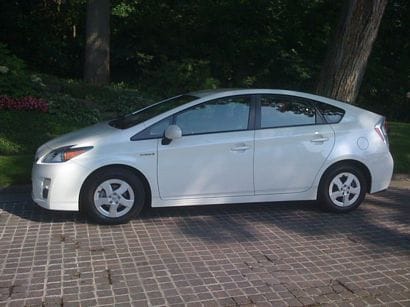
On the road
On the road, the Prius has a well-controlled ride, although there is noticeable body lean in tight corners that quickly summons up the stability control system. In addition, there is a noticeable lack of feedback from the electric steering.
Although hardly a contender in the stoplight grand prix, acceleration is fairly brisk if you decide to put your foot into it. Braking as well as feedback from the brake pedal was also excellent - although the feel of the brake regen system takes a bit of getting used to.
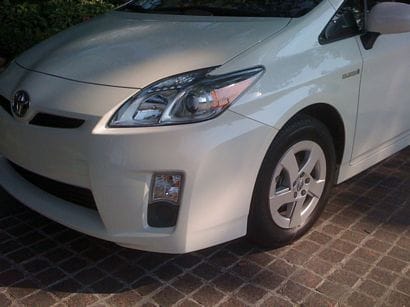
Pricing
Toyota new car dealer prices, including a $760 destination charge, begins at $23,520 for the Prius Two and could top out at $40,000 or more for a Prius Five with all the bells and whistles. Our Blizzard Pearl Prius Four had a base price of $26,850. Adding navigation ($2,380), special color ($220), bumper appliqué ($69), plus security system ($359) and all the floor mats plus a first aid kit ($280) meant that the vehicle we tested checked in at $30,918.

The Bottom Line
I would be the first to state that the Toyota Prius isn’t for everybody. Even with 24 more horses and an additional 23 pound-feet of torque over the previous version, nobody is going to mistake the current iteration for a sports sedan.
In all fairness, however, others that have tested the Prius Five that comes equipped with 17-inch wheels, 215/45 tires, firmer shock tuning and quicker steering have stated that this package addresses some of the handling issues.
It’s my feeling that customers choose a Prius for two reasons. The first is that they’re environmentally conscious. The second is that they want everyone else to know they’re environmentally conscious – something that Toyota has really nailed with the vehicle’s distinctive design and improved upon especially when it comes to the interior of this third generation model.
So it comes down to this: those who value fuel efficiency and uniqueness over handling and performance should find the new Toyota Prius to be nearly their ideal vehicle.
2011 Prius Review Video
View our 2011 Toyota Prius Video Review on LotPro's YouTube channel.












